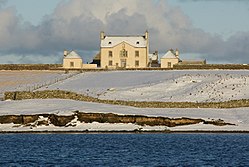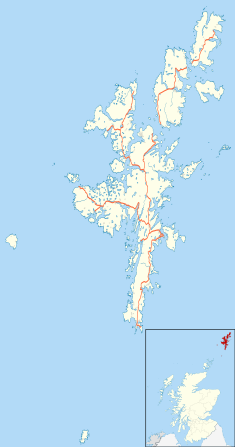
Shugborough Hall is a stately home near Great Haywood, Staffordshire, England.

The Castle of Mey is located in Caithness, on the north coast of Scotland, about 6 miles (10 km) west of John o' Groats. In fine weather there are views from the castle north to the Orkney Islands.
Unst is one of the North Isles of the Shetland Islands, Scotland. It is the northernmost of the inhabited British Isles and is the third-largest island in Shetland after Mainland and Yell. It has an area of 46 sq mi (120 km2).
Annick Lodge is an estate between Perceton and Cunninghamhead in North Ayrshire, Scotland.

Cambo Estate lies close to the village of Kingsbarns in north-east Fife, Scotland. It is within the East Neuk, 10 kilometres (6.2 mi) south-east of St Andrews. At the heart of the estate lies the 19th-century Cambo House, the home of Sir Peter Erskine, Bt and Lady Catherine Erskine. The gardens of Cambo are open to the public, and include the walled garden and seasonal snowdrop gardens. Elsewhere on the estate is the Kingsbarns Golf Links golf course, which co-hosts the Alfred Dunhill Links Championship every year.
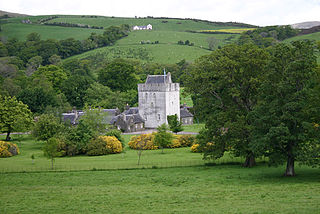
Kames Castle is a 16th-century tower house located on the shore of Kames Bay near Port Bannatyne, on the Isle of Bute, Scotland. The castle, which is set in 20 acres (81,000 m2) of planted grounds, includes a 2-acre (8,100 m2) 18th-century walled garden. It is extended through the addition of a range of stone cottages. The castle, cottages, walled garden and other estate buildings are category B listed buildings.

Dumfries House is a Palladian country house located in the town of Cumnock in East Ayrshire, Scotland. It is within a large estate, around two miles (3 km) west of Cumnock. Noted for being one of the few such houses with much of its original 18th-century furniture still present, including specially commissioned Thomas Chippendale pieces, the house and estate is now owned by The Prince's Foundation, a charity which maintains it as a visitor attraction and hospitality and wedding venue. Both the house and the gardens are listed as significant aspects of Scottish heritage.
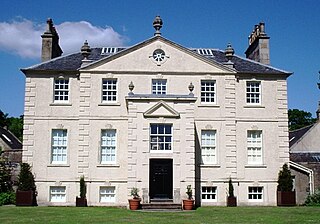
Greenbank Garden is a 2.5-acre (10,000 m2) 18th century walled garden in Carolside, Clarkston, East Renfrewshire, Scotland, owned and operated by the National Trust for Scotland and open to the public. It is situated about six miles (10 km) from the centre of Glasgow. The garden, which is included on the Inventory of Gardens and Designed Landscapes in Scotland, surrounds Greenbank House, a Category A listed building. The house has sixteen rooms, and also barns and stables.
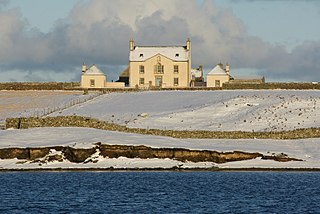
Belmont is a settlement and ferry terminal in southern Unst in the Shetland Islands. The ferry crosses from here to Gutcher in Yell and to Hamars Ness in Fetlar.

Mavisbank is a country house outside Loanhead, south of Edinburgh in Midlothian, Scotland. It was designed by architect William Adam in collaboration with his client, Sir John Clerk of Penicuik, and was constructed between 1723 and 1727. The first Palladian villa in Scotland, it is described by Historic Scotland as "one of Scotland's most important country houses". It was altered in the 19th century, but suffered decades of neglect in the 20th century. The interiors were gutted by fire in 1973, and the house remains a ruin. As of May 2009, plans exist to partially restore the building and manage the estate as a community asset.
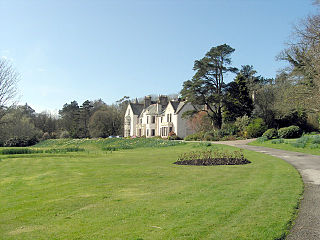
Achamore House is a mansion on the Isle of Gigha, Scotland. It was built in 1884 for Lt-Col William James Scarlett, and the extensive gardens were laid out by Sir James Horlick from 1944. The house is protected as a category B listed building, while the grounds are included in the Inventory of Gardens and Designed Landscapes in Scotland.

Ayton Castle is located to the east of Ayton in the Scottish Borders. It is 9 kilometres (5.6 mi) north-west of Berwick-upon-Tweed, in the former county of Berwickshire. Built around a medieval tower house, the present castle dates largely from the 19th century. Ayton Castle is the caput of the feudal barony of Ayton. The castle is protected as a category A listed building, and the grounds are included in the Inventory of Gardens and Designed Landscapes in Scotland, the national listing of significant parks and gardens.

Dalzell House is a historic house in Motherwell, North Lanarkshire, Scotland. It is located to the south of the town, on the north bank of the River Clyde. At its core is a 15th-century tower house, with extensive additions built during the 17th and 19th centuries. In the 1980s the house was restored and divided for sale as eighteen private apartments, while the surrounding Dalzell estate is now owned by North Lanarkshire Council. The house is protected as a Category A listed building, and the grounds are listed on the Inventory of Gardens and Designed Landscapes in Scotland.

Brough Lodge is a 19th-century Gothic mansion on Fetlar, one of the Shetland Islands, in northern Scotland. Built by the Nicolson family, who were responsible for clearing Fetlar of many of its inhabitants, it has been disused since the 1980s. The Brough Lodge Trust has recently started work to restore the building. The house is protected as a category A listed building, and the grounds are included in the Inventory of Gardens and Designed Landscapes in Scotland, the national listing of significant gardens.

Lunna House is a 17th-century laird's house on Lunna Ness in the Shetland Islands. Lunna House is noted for having "the best historic designed landscape in Shetland". In the 20th century it was used as a base of the wartime Shetland Bus operation.

Gardie House is an 18th-century estate house on Bressay in Shetland, Scotland. Located opposite Lerwick, across the Bressay Sound, Gardie is described by Historic Scotland as an "example of the smaller Scottish country house, unique in Shetland."

Formakin House is an early 20th-century mansion and estate in Renfrewshire, Scotland. It is located 2 kilometres (1.2 mi) south of the Firth of Clyde, and 2.5 kilometres (1.6 mi) west of Bishopton. Formakin was designed by Robert Lorimer for wealthy businessman John Holms, though the main house was never completed. It declined during the 20th century, but in the 1990s, restoration of the estate buildings was completed.

Cleish Castle is a 16th-century tower house in Kinross-shire, Scotland. It is sited 5 kilometres (3.1 mi) south-west of Kinross and 1 kilometre (0.62 mi) west of the hamlet of Cleish. It was built by the Colville family, who owned it until 1775. It was restored and remodelled in the mid 19th century, and restored again in the 20th century. It remains a private residence and is a category A listed building. The grounds of the castle are included in the Inventory of Gardens and Designed Landscapes in Scotland, the national listing of significant Scottish gardens.

Duncraig Castle is a mansion in Lochalsh, in the west of the Scottish Highlands. A category-C listed building, it is situated in the Highland council area, east of the village of Plockton on the south shore of Loch Carron. It was built in 1866 in the Scottish baronial style, to designs by Alexander Ross, for Scottish Member of Parliament and businessman Alexander Matheson. The castle remained in the Matheson family until the 1920s, when it was sold to Sir Daniel Hamilton and his wife Margaret, who owned the neighbouring estate. The Hamiltons intended to use the castle for educational purposes in the local community, but this never came to fruition and following the outbreak of World War II, the castle was used as a naval hospital. By the end of the war, Daniel Hamilton had died, and Margaret bequeathed the castle to the local council, which converted it for use as a home economics college for girls, operating in this capacity until its closure in 1989.
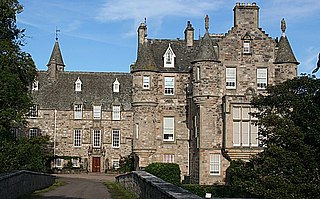
Cullen House is a large house, about 1 kilometre (0.6 mi) south-west of the coastal town of Cullen in Moray, Scotland. It was the seat of the Ogilvies of Findlater, who went on to become the Earls of Findlater and Seafield, and it remained in their family until 1982. Building work started on the house in 1600, incorporating some of the stonework of an earlier building on the site. The house has been extended and remodelled several times by prominent architects such as James Adam, John Adam, and David Bryce. It has been described by the architectural historian Charles McKean as "one of the grandest houses in Scotland" and is designated a Category A listed building. The grounds were enlarged in the 1820s when the entire village of Cullen, save for Cullen Old Church, was demolished to make way for improvements to the grounds by Lewis Grant-Ogilvy, 5th Earl of Seafield; a new village, closer to the coast, was constructed for the inhabitants. Within the grounds are a bridge, a rotunda and a gatehouse, each of which is individually listed as a Category A structure.
